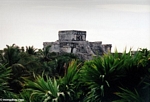Slash-and-burn agriculture in Belize. Photo by: Rhett A. Butler.
A NASA funded expedition using airborne lasers to study ancient Mayan ruins has also documented widespread illegal deforestation in the Caracol Archaeological Reserve. The lasers found that forest disturbance was actually 58 percent greater than recent satellite surveys showed, according new study in mongabay.com’s open access journal Tropical Conservation Society (TCS). Such deforestation not only imperils biodiversity, carbon storage, and migration routes for Central American species, but could also lead to plundering of the Maya site of Caracol.
The NASA research employed a system known as LiDAR (Light Detection And Ranging) to discover unfound archeological sites in the jungle, once home to one of the Maya’s greatest cities. But the expedition also provided greater insight into deforestation in the 10,340-hectare Caracol Archaeological Reserve, due to the sensitivity of the lasers even over satellite imagery. The new data shows that in all 11 percent of the reserve has been disturbed by illegal deforestation.
“Unfortunately, as we are learning more about the archaeological remains at Caracol with LiDAR, this same technology is also detailing extensive modern deforestation and looting along the Guatemala-Belize border that is encroaching several kilometers into the archaeological reserve and threatening the preservation of Belize’s cultural and natural heritage,” the scientists write.
The loss of forests within Caracol Archaeological Reserve imperils a massive wildlife corridor that allows animals to move freely from Mexico throughout much of Central America.
“These forested areas function as important components of the Mesoamerican Biological Corridor, which is being continually threatened by changes in human land use patterns within and beyond Belize,” the authors write.
The use of LiDAR to detect even smallscale forest disturbance makes it a tool of the future for forest monitoring. The only impediment, according to the researchers, is its high cost.
Belize has lost over 13 percent of its forest since 1980.
CITATION: Weishampel, J. F., Hightower, J. N., Chase, A. F. and Chase, D. Z. 2012. Use of airborne LiDAR to delineate canopy degradation and encroachment along the Guatemala-Belize border. Tropical Conservation Science Vol. 5(1):12-24.
Related articles
Belize lost 10,000 ha of forest per year since 1980
(11/07/2010) Forests in Belize have been cleared at a rate of nearly 10,000 hectares per year for the past 30 years, a recent study shows. In 1980, forests covered 79.5% of the land surface of Belize but as of February 2010 it had decreased to 62.7%. The area covered by forests in the country thus went from about 6500 square miles 30 years ago to around 5300 square miles today, losing an area the size of Rhode Island.
Evidence mounts that Maya did themselves in through deforestation

(12/08/2011) Researchers have garnered further evidence for a smoking gun behind the fall of the great Maya civilization: deforestation. At the American Geophysical Union (AGU) conference, climatologist Ben Cook presented recent research showing how the destruction of rainforests by the Mayan ultimately led to declines in precipitation and possibly civilization-rocking droughts. While the idea that the Maya may have committed ecological-suicide through deforestation has been widely discussed, including in Jared Diamond’s popular book Collapse, Cook’s findings add greater weight to the theory.
Harpy eagles nest in Belize for the first time in over 60 years (pictures)
(01/06/2011) Scientists have confirmed the presence of a harpy eagle nest in the Maya Mountains of Belize. The discovery represents the most northerly breeding pair in the Americas, and signals a comeback for a species which has become locally extinct in much of Central America due to human activity.